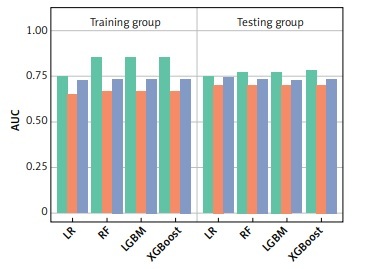Current issue
Archive
Manuscripts accepted
About the Journal
Editorial office
Editorial board
Section Editors
Abstracting and indexing
Subscription
Contact
Ethical standards and procedures
Most read articles
Instructions for authors
Article Processing Charge (APC)
Regulations of paying article processing charge (APC)
CLINICAL RESEARCH
Red blood cell distribution width-to-albumin ratio: a prognostic biomarker of sepsis patients
1
General Medicine Department, Guangdong Provincial Key Laboratory of Major Obstetric Diseases, Guangdong Provincial Clinical Research Center for Obstetrics and Gynecology, The Third Affiliated Hospital of Guangzhou Medical University, GuangZhou, China
2
Department of Cardiovascular Medicine, Huizhou Third People’s Hospital, Guangzhou Medical University, HuiZhou, China
3
Clinical Laboratory Center, Third Affiliated Hospital of Sun Yat-sen University, Guangzhou, China
Submission date: 2023-10-30
Final revision date: 2023-12-05
Acceptance date: 2023-12-19
Online publication date: 2024-04-15
Corresponding author
KEYWORDS
TOPICS
ABSTRACT
Introduction:
To explore the association of red blood cell distribution width-to-albumin ratio (RAR) with 28-day mortality among septic patients, as well as to develop predictive models for evaluating the prognostic significance of RAR.
Material and methods:
Relevant information was obtained from the Medical Information Mart for Intensive Care (MIMIC-III). A total of 1475 individuals diagnosed with sepsis were enrolled. Data on patients’ age, creatinine levels, and mechanical ventilation status in the initial 24 h after intensive care unit (ICU) admission were gathered. We employed multivariate COX analyses to investigate the correlation between RAR and 28-day mortality, and we conducted subgroup analyses stratified by gender, age, intervention modality, and disease progression. We established 4 prediction models relevant to RAR to forecast the 28-day mortality of septic patients. Additionally, we evaluated the predictive value using receiver operator characteristic curves.
Results:
The significance of the association between RAR and 28-day mortality was maintained among sepsis patients regardless of their use or non-use of mechanical ventilation or vasopressor, presence or absence of septic shock, and gender (male or female). Additionally, these developed models associated with RAR demonstrated a good predictive value in forecasting the 28-day mortality rate among septic patients.
Conclusions:
This study provides evidence, suggesting a significant correlation between RAR and the 28-day mortality among sepsis patients of ICU admission. It might show promise of RAR as a potential dependable prognostic marker for the prediction of 28-day mortality in sepsis patients.
To explore the association of red blood cell distribution width-to-albumin ratio (RAR) with 28-day mortality among septic patients, as well as to develop predictive models for evaluating the prognostic significance of RAR.
Material and methods:
Relevant information was obtained from the Medical Information Mart for Intensive Care (MIMIC-III). A total of 1475 individuals diagnosed with sepsis were enrolled. Data on patients’ age, creatinine levels, and mechanical ventilation status in the initial 24 h after intensive care unit (ICU) admission were gathered. We employed multivariate COX analyses to investigate the correlation between RAR and 28-day mortality, and we conducted subgroup analyses stratified by gender, age, intervention modality, and disease progression. We established 4 prediction models relevant to RAR to forecast the 28-day mortality of septic patients. Additionally, we evaluated the predictive value using receiver operator characteristic curves.
Results:
The significance of the association between RAR and 28-day mortality was maintained among sepsis patients regardless of their use or non-use of mechanical ventilation or vasopressor, presence or absence of septic shock, and gender (male or female). Additionally, these developed models associated with RAR demonstrated a good predictive value in forecasting the 28-day mortality rate among septic patients.
Conclusions:
This study provides evidence, suggesting a significant correlation between RAR and the 28-day mortality among sepsis patients of ICU admission. It might show promise of RAR as a potential dependable prognostic marker for the prediction of 28-day mortality in sepsis patients.
Share
RELATED ARTICLE
We process personal data collected when visiting the website. The function of obtaining information about users and their behavior is carried out by voluntarily entered information in forms and saving cookies in end devices. Data, including cookies, are used to provide services, improve the user experience and to analyze the traffic in accordance with the Privacy policy. Data are also collected and processed by Google Analytics tool (more).
You can change cookies settings in your browser. Restricted use of cookies in the browser configuration may affect some functionalities of the website.
You can change cookies settings in your browser. Restricted use of cookies in the browser configuration may affect some functionalities of the website.



